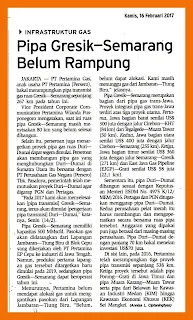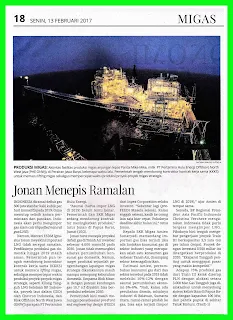PT Pertamina, through its subsidiary, PT Pertamina Gas (Pertagas), will be working on two gas transmission pipelines in this year worth US $ 470 million, the Semarang-Gresik pipeline and Duri-Dumai. Last year, the company has completed three pipeline segments.
Vice President Corporate Communications Pertamina Wianda Pusponegoro admitted, only two pipeline projects that will be done this year. Because, three other pipeline projects have been completed and started operation last year. Thus, the company just completed the Semarang-Gresik pipeline and begin construction of Duri-Dumai. "The completion of Gresik-Semarang, 270 kilometers (km) of 70-80 km there yet. Then it will begin Project Duri-Dumai, "he said.
Semarang-Gresik pipeline has a capacity of 500 million standard cubic het per day / MMSCFD and 267 km long. The plan, Semarang-Gresik pipeline will carry gas from Jambaran-Tiung Blue undertaken by PT Pertamina EP Cepu, Central Java industry. This pipeline with an investment of US $ 360 million is part of the pipe Transjawa.
Transjawa gas pipeline integration project consists of three major projects. First, the western part of Java. worth US $ 300 million with a path-KHT Cirebon (84 km) and Tegalgede-Muara Tawar (50 km). Second, Northern Java, worth US $ 400 million to Cirebon-Semarang lines (255 km). Third, East Java, worth US $ 360 million with the Semarang-Gresik (271 km) and East Java Gas Pipeline (EJGP) -Grati worth US $ 58 million (22.1 km).
While Pipeline Project Duri-Dumai be done Pertamina and PGN. This is according to the Decree of the Minister of Energy and Mineral Resources No. 4975 K / 12 / MEM / 2016 Based on this rule, the two companies had to build and operate the pipeline sections together. Spoken budget was also derived from the respective companies. Duri-Dumai pipeline is planned to be held during 70 km. The total investment required, based on estimates Pertagas, approximately US $ 70 million.
The supply of gas from the Corridor Block and Bentu partly given to Pertagas to refineries owned by PT Pertarnina and industry through PGN. Furthermore, the Ministerial Decree states that the company is required to complete the construction of Pipe Duri-Dumai at the latest by the first quarter / 2017.
Meanwhile, three pipes that Pertamina was completed last year is Pipe Kawasan Industri Medan (KIM) to Special Economic Zones (SEZ) Mangkei Sei, Pipe-RoW Porong in East Java and Muara Karang Pipe-Muara. The investment value of the three pipes have reached US $ 826.3 million, including Arun Pipe-Belawan is inline with the pipe KIM-KEK. Pipe-Muara Karang Muara Tawar 35 km will carry gas from the storage unit and the floating (floating storage and regasification unit / FSRU) owned by PT Nusantara Regas. Porong pipe-RoW 57 km will carry gas from Santos Indonesia to PTPLN 25 MMSCFD.
Lastly, Pipe KIM-KEK 139 km connecting pipeline Arun-Belawan that transports gas from Arun Regasification Facility in Aceh. With the addition of these three pipelines, the total length of transmission and distribution pipelines Pertamina reach 2,580 km. The realization of new 25.8% of the company's target to have 10 thousand km pipeline in 2025. In the past two years, the company continues to add to the pipeline it operates.
Up Thin
Meanwhile, over the last 2016, Pertamina recorded a rise in the commercial realization and gas regasification. Commercial gas in the past year totaled 709 trillion British thermal units (TBTU), edged up 0.4% from the realization in 2015 that amounted to 706 TBTU. While the regasification of gas in 2016 reached 29.9 TBTU or an increase of 8.4% from the previous year of 27.5 TBTU. Meanwhile, Pertamina gas transportation was down 1.7% and 531 billion cubic feet in 2015 to 522 billion cubic feet last year.
According Wianda, gas business performance last year it has not calculated the impact of the completion of the Pipe-Muara Karang Muara Tawar and Porong-RoW. Later, gas business performance will improve with the completion of the construction of gas infrastructure. After three transmission pipeline was put into operation, the volume of gas transported diniagakan and Pertamina is expected to rise.
"All new investments in infrastructure, including gas intended to increase the volume of gas transportation and commerce, including regasification volume," said Wianda.
IN INDONESIAN
Pertamina Garap Dua Pipa Gas Senilai US$ 470 Juta
PT Pertamina melalui anak usahanya, PT Pertamina Gas (Pertagas), akan menggarap dua pipa transmisi gas pada tahun ini senilai US$ 470 juta, yakni Pipa Gresik-Semarang dan Duri-Dumai. Tahun lalu, perusahaan telah merampungkan tiga ruas pipa.
Vice President Corporate Communication Pertamina Wianda Pusponegoro mengakui, hanya dua proyek pipa yang akan dikerjakan pada tahun ini. Karena, tiga proyek pipa lainnya telah selesai dan mulai beroperasi pada tahun lalu. Sehingga, perusahaan hanya merampungkan Pipa Gresik-Semarang dan memulai pembangunan Duri-Dumai. “Penyelesaian Gresik-Semarang, dari 270 kilometer (km) ada 70-80 km yang belum. Kemudian akan dimulai Proyek
Duri-Dumai," kata dia.
Pipa Gresik-Semarang memiliki kapasitas 500 million standard cubic het per day/mmscfd dan panjang 267 km. Rencananya, Pipa Gresik-Semarang akan mengalirkan gas dari Lapangan Jambaran-Tiung Biru yang dikerjakan PT Pertamina EP Cepu ke industri Jawa Tengah. Pipa ini dengan nilai investasi US$ 360 juta ini merupakan bagian dari Pipa Transjawa.
Proyek integrasi pipa gas Transjawa terdiri atas tiga proyek utama. Pertama, Jawa bagian Barat. senilai US$ 300 juta dengan jalur Cirebon-KHT (84 km) dan Tegalgede-Muara Tawar (50 km). Kedua, Jawa bagian Utara senilai US$ 400 juta dengan jalur Cirebon-Semarang (255 km). Ketiga, Jawa bagian Timur senilai US$ 360 juta dengan jalur Semarang-Gresik (271 km) dan East Java Gas Pipeline (EJGP)-Grati senilai US$ 58 juta (22,1 km).
Sementara Proyek Pipa Duri-Dumai harus dikerjakan Pertamina bersama PT PGN. Hal ini sesuai Keputusan Menteri Energi dan Sumber Daya Mineral No 4975 K/ 12/ MEM/ 2016. Berdasarkan aturan ini, kedua perusahaan harus membangun dan mengoperasikan secara bersama ruas pipa tersebut. Anggaran yang dipakai pun juga berasal dari masing-masing perusahaan. Pipa Duri-Dumai ini rencananya akan digelar sepanjang 70 km. Total investasi yang dibutuhkan, berdasarkan perkiraan Pertagas, sekitar US$ 70 juta.
Pasokan gas dari Blok Koridor dan Blok Bentu sebagian diberikan kepada Pertagas untuk kilang milik PT Pertarnina dan industri melalui PGN. Lebih lanjut Keputusan Menteri tersebut menyebutkan bahwa kedua perusahaan wajib merampungkan pembangunan Pipa Duri-Dumai paling lambat hingga kuartal I/ 2017.
Sementara itu, tiga pipa yang dirampungkan Pertamina pada tahun lalu adalah Pipa Kawasan Industri Medan (KIM) hingga Kawasan Ekonomi Khusus (KEK) Sei Mangkei, Pipa Porong-Grati di Jawa Timur dan Pipa Muara Karang-Muara Tawar. Nilai investasi ketiga pipa ini mencapai US$ 826,3 juta, termasuk Pipa Arun-Belawan yang sejalur dengan Pipa KIM-KEK. Pipa Muara Karang-Muara Tawar 35 km akan mengalirkan gas dari unit penampungan dan regasifikasi terapung (floating storage and regasification unit/FSRU) milik PT Nusantara Regas. Pipa Porong-Grati 57 km akan mengalirkan gas dari Santos Indonesia ke PTPLN 25 mmscfd.
Terakhir, Pipa KIM-KEK 139 km menyambung Pipa Arun-Belawan yang mengalirkan gas dari Fasilitas Regasifikasi Arun di Aceh. Dengan tambahan tiga pipa ini, total panjang pipa transmisi dan distribusi Pertamina mencapai 2.580 km. Realisasi ini baru 25,8% dari target perusahaan untuk memiliki pipa sepanjang 10 ribu km pada 2025 nanti. Dalam dua tahun terakhir, perusahaan terus menambah pipa yang dioperasikannya.
Naik Tipis
Sementara itu, selama 2016 lalu, Pertamina mencatatkan kenaikan realisasi niaga dan regasifikasi gas. Niaga gas pada tahun lalu tercatat mencapai 709 triliun british thermal unit (TBTU), naik tipis 0,4% dari realisasi 2015 yang sebesar 706 TBTU. Sementara regasifikasi gas 2016 mencapai 29,9 TBTU atau meningkat 8,4% dari tahun sebelumnya 27,5 TBTU. Sementara itu, transportasi gas Pertamina tercatat turun 1,7% dan 531 miliar kaki kubik pada 2015 menjadi 522 miliar kaki kubik pada tahun lalu.
Menurut Wianda, kinerja bisnis gas tahun lalu itu belum menghitung dampak dari selesainya Pipa Muara Karang-Muara Tawar dan Porong-Grati. Nantinya, kinerja bisnis gas akan membaik seiring selesainya pembangunan infrastruktur gas. Setelah tiga pipa transmisi tadi mulai beroperasi, volume gas yang diniagakan dan ditransportasikan Pertamina diperkirakan akan naik.
“Semua investasi baru di infrastruktur gas termasuk ditujukan untuk meningkatkan volume transportasi dan niaga gas, termasuk volume regasifikasi,” kata Wianda.
Kontan, Page-14, Thursday, Feb, 16, 2017








